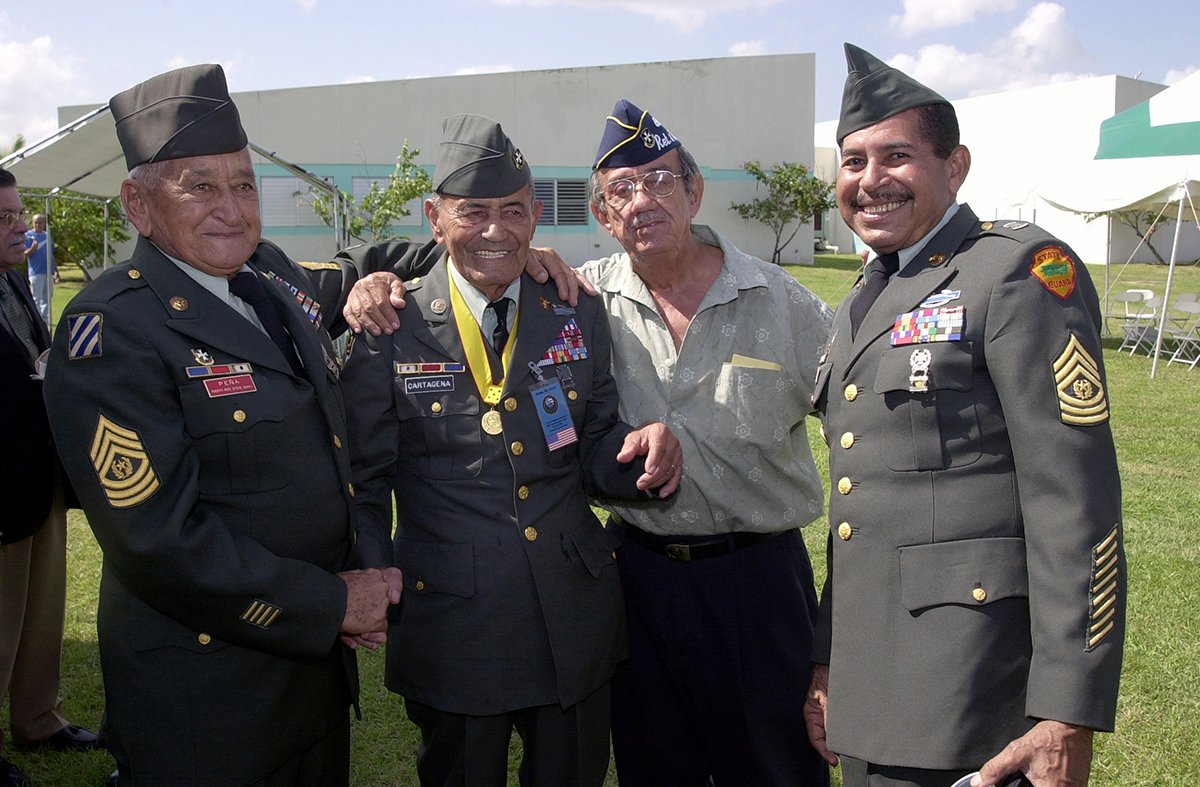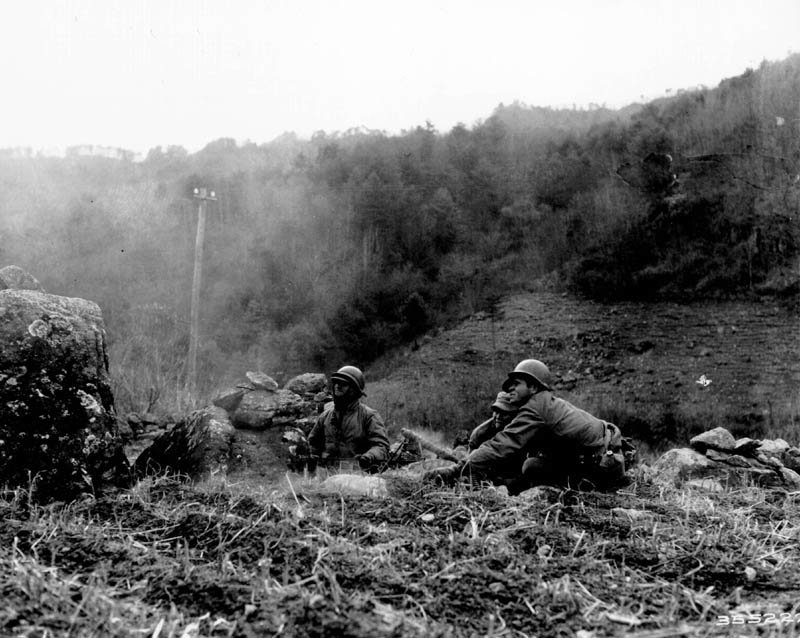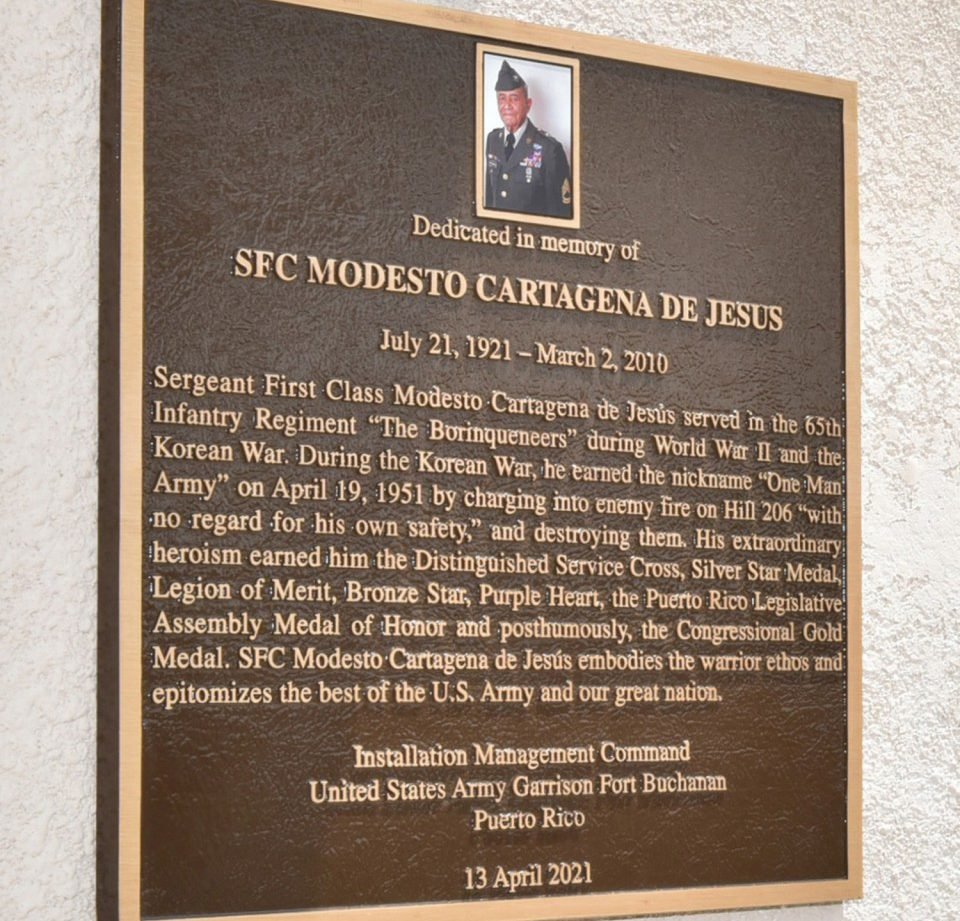How the Most Decorated Hispanic Soldier of the Korean War Became a ‘One Man Army’

Korean War veterans Command Sgt. Maj. Jose Pene, left; Sgt. 1st. Class Modesto Cartagena de Jesús, second left; and Command Sgt. Maj. Angel Kuiland, right; during a ceremony at the US Army Reserve center in Puerto Nuevo, Puerto Rico, Feb. 12, 2000. Photo courtesy of the National Archives.
Army Sgt. 1st Class Modesto Cartagena de Jesús is considered the most decorated Hispanic soldier of the Korean War. He was awarded nearly every medal for valor except the Medal of Honor, including the Distinguished Service Cross, the Silver Star, the Legion of Merit, two Bronze Stars, and a Purple Heart.
Cartagena was born July 21, 1921, and raised in the mountain village of Cayey, Puerto Rico. He was among the first volunteers to enlist in the US Armed Forces when the country entered World War II. In that war, as well as in the Korean War, he served in the famed 65th Infantry Regiment, the only all-Hispanic regiment in the US Army.
And while some Americans disparaged the regiment as a “rum and Coca-Cola outfit” — a racial attack on the unit’s Latino members — the men within its ranks soon adopted another nickname: the “Borinqueneers.” Although they were racially segregated and demeaned, the soldiers also received great praise from their commanding officer in the Korean War, Brig. Gen. William Harris. He called the Borinqueneers “the best damn soldiers in that war.”

Cartagena’s actions at Hill 206 near Yonch’on on April 19, 1951, cemented his legendary status as the Borinqueneers’ “One Man Army.”
A sergeant in a squad of the 3rd Platoon in Company C, Cartagena arrived at the rice paddies below Hill 206. The Chinese pinned down his unit with direct and intense crossfire. In order to maneuver on the enemy, Cartagena led his squad at a crawl toward the enemy’s rear left flank. During their advance, one of Cartagena’s soldiers, Pfc. Antonio Colon Flores, was killed in action. Another 11 men were wounded.
“The soldier who carried the automatic rifle called out to me,” Cartagena later recalled. “He had been wounded by two rounds to his thigh. I dragged myself to him, applied morphine and filled out an evacuation card.”
During the gunfight, Cartagena’s rifle was broken into two pieces. He took the wounded soldier’s automatic weapon, ammunition, and grenades, and he continued uphill alone.

“The Chinese would hurl their grenades at me and I would catch them in the air and quickly throw them through the air opening in the Chinese trenches,” he said. “They would take cover and I would advance my position. And that’s how I destroyed a Chinese position that was nearby.”
When he reached the top of the hill, Cartagena thought he still had two or three soldiers by his side, but he was alone. He encountered some 80 to 100 Chinese soldiers ensconced in their mortar nests — they wielded three mortars, three machine guns, and five automatic weapons. Cartagena reached the first mortar nest and silenced it with a hand grenade. He first sprayed automatic fire into the second mortar nest before destroying the position with an explosive charge.
“And that’s how I destroyed three positions with machine guns, mortars and five automatic weapons,” Cartagena said. “When the Chinese discovered my position, they threw so many grenades that three landed on me. One landed on my back, another in between my legs and the third on my right side. The last one wounded me. The bone was sticking out from my arm. I lost a lot of blood, but luckily I didn’t faint. I kept fighting wounded for almost 3 hours.”
Eventually, the Chinese withdrew from the hill, taking their wounded with them. Alone, Cartagena took possession of the hill. He’d personally killed 33 Chinese soldiers who’d been hunkered down in machine-gun and automatic weapons emplacements at the summit, as well as 15 more enemy soldiers scattered in positions situated along the hill’s slope. After the battle, Cartagena assigned two squads to assist a stuck tank and two more squads to conduct searches for the dead and wounded. Then, and only then, did Cartagena return to a first-aid station, where he received lifesaving medical attention.
Cartagena was awarded the Distinguished Service Cross, the nation’s second-highest achievement for bravery after the Medal of Honor. He served a total of 20 years in the Army and died in 2010 at age 88.
Read Next: The Borinqueneers: The US Army’s Only All-Hispanic Unit

Matt Fratus is a history staff writer for Coffee or Die. He prides himself on uncovering the most fascinating tales of history by sharing them through any means of engaging storytelling. He writes for his micro-blog @LateNightHistory on Instagram, where he shares the story behind the image. He is also the host of the Late Night History podcast. When not writing about history, Matt enjoys volunteering for One More Wave and rooting for Boston sports teams.
BRCC and Bad Moon Print Press team up for an exclusive, limited-edition T-shirt design!
BRCC partners with Team Room Design for an exclusive T-shirt release!
Thirty Seconds Out has partnered with BRCC for an exclusive shirt design invoking the God of Winter.
Lucas O'Hara of Grizzly Forge has teamed up with BRCC for a badass, exclusive Shirt Club T-shirt design featuring his most popular knife and tiomahawk.
Coffee or Die sits down with one of the graphic designers behind Black Rifle Coffee's signature look and vibe.
Biden will award the Medal of Honor to a Vietnam War Army helicopter pilot who risked his life to save a reconnaissance team from almost certain death.
Ever wonder how much Jack Mandaville would f*ck sh*t up if he went back in time? The American Revolution didn't even see him coming.
A nearly 200-year-old West Point time capsule that at first appeared to yield little more than dust contains hidden treasure, the US Military Academy said.












